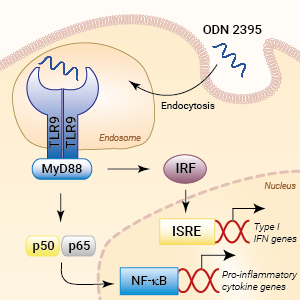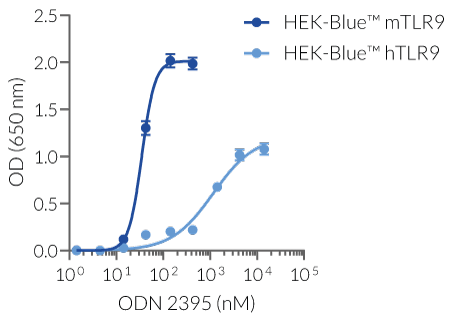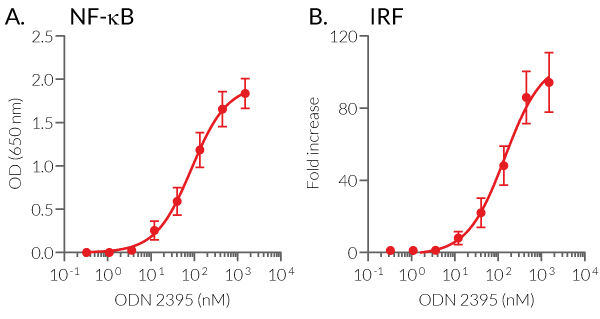ODN 2395 VacciGrade™
| Product | Unit size | Cat. code | Docs. | Qty. | Price | |
|---|---|---|---|---|---|---|
|
ODN 2395 VacciGrade™ CpG ODN, Class C (human/mouse) - TLR9 agonist |
Show product |
1 mg |
vac-2395-1
|
|
CpG ODN, type C (human/mouse) - TLR9-based vaccine adjuvant
 InvivoGen also offers:
InvivoGen also offers:
• TLR reporter cells: HEK293, RAW, THP-1 cells
• TLR research tools: Antibodies, Inhibitors, etc.
ODN 2395 VacciGrade™ is a Class C CpG oligonucleotide (ODN), specific for the human and murine Toll-like receptor 9 (TLR9) [1]. It is a short synthetic single-stranded DNA molecule containing unmethylated CpG dinucleotides (CpG motifs). These unmethylated CpG motifs mimic microbial DNA and act as immunostimulants via TLR9.
Class C CpG ODNs, such as ODN 2395, combine classes A and B features. They contain a complete phosphorothioate (PS) backbone and a CpG-containing palindromic motif. They strongly induce B cell stimulation as well as IFN-α production in plasmacytoid dendritic cells [2]. Moreover, they generate Th1-dominant immune responses and thus, are potential adjuvants for human vaccines to elicit protective Th1 immunity [2].
InvivoGen's ODN 2395 VacciGrade™ is a strong TLR9 agonist as verified using our HEK-Blue™ reporter cell lines expressing human or mouse TLR9 (see figure). Moreover, ODN 2395 VacciGrade™ activates the hTLR9-dependent NF-κB and IRF pathways, as assessed using our THP1-Dual™ hTLR9 reporter cell line expressing two reporter genes, for the NF-κB-inducible SEAP and IRF-inducible Lucia luciferase, as well as hTLR9 (see figure).
VacciGrade™ is a high-quality pre-clinical grade, suitable for in vivo use.
A standard grade ODN 2395 for in vitro assays is also available.
ODN 2395 VacciGrade™ is for research use only, and not for human or veterinary use. It is not a pharmaceutical preparation fit for vaccine manufacturing.
![]() Get more information about CpG ODNs Classes.
Get more information about CpG ODNs Classes.
References
1. Roda JM. et al., 2005. CpG-containing oligodeoxynucleotides act through TLR9 to enhance the NK cell cytokine response to antibodycoated tumor cells. J Immunol. 175(3):1619-27.
2. Jurk M. et al., 2004. C-Class CpG ODN: sequence requirements and characterization of immunostimulatory activities on mRNA level. Immunobiology. 209(1-2):141-54.
Specifications
ODN 2395 sequence: 5’-tcgtcgttttcggcgc:gcgccg-3’ (22 mer)
Description: TLR9 agonist VacciGrade™
Polarization of adaptive immune response: Th1 response
Working concentration: 20-50 µg/mouse.
Quality control:
- Sterility guaranteed
- The absence of bacterial contamination (lipoproteins & endotoxins) has been confirmed using HEK-Blue™ TLR2 and HEK-Blue™ TLR4 cells
- Endotoxin level < 1 EU/mg (measurement by kinetic chromogenic LAL assay)
Contents
- 1 mg (141.85 nmol) of sterile lyophilized ODN 2395 VacciGrade™
- 10 ml sterile endotoxin-free physiological water (NaCl 0.9%)
![]() ODN 2395 VacciGrade™ is shipped at room temperature
ODN 2395 VacciGrade™ is shipped at room temperature
![]() Should be stored at -20°C for up to 1 year.
Should be stored at -20°C for up to 1 year.
Upon resuspension, prepare aliquots of ODN 2395 VacciGrade™ and store at -20°C.
![]() Product is stable 6 months at -20°C when properly stored.
Product is stable 6 months at -20°C when properly stored.
![]() Avoid repeated freeze-thaw cycles.
Avoid repeated freeze-thaw cycles.
VacciGrade™
VacciGrade™ is a high-quality pre-clinical grade. VacciGrade™ products are filter-sterilized (0.2 µm) and filled under strict aseptic conditions in a clean room*. The absence of bacterial contamination is assessed by a sterility test using a pharmacopeia-derived assay. The level of bacterial contaminants (endotoxins and lipoproteins) in each lot is verified using a LAL assay and/or a TLR2 and TLR4 reporter assay.
*Except for LPS VacciGrade™, which is prepared in a laminar flow hood dedicated to LPS.
Details
CpG ODNs
Synthetic oligodeoxynucleotides containing unmethylated CpG motifs (CpG ODNs), such as ODN 1018, have been extensively studied as adjuvants [1]. These CpG motifs are present at a 20-fold greater frequency in bacterial DNA compared to mammalian DNA [2]. CpG ODNs are recognized by the Toll-like receptor 9 (TLR9), which is expressed on human B cells and plasmacytoid dendritic cells (pDCs), thereby inducing Th1-dominated immune responses [3]. Pre-clinical studies, conducted in rodents and non-human primates, as well as human clinical trials, have demonstrated that CpG ODNs can significantly improve vaccine-specific antibody responses [1]. Three types of stimulatory CpG ODNs have been identified, types A, B, and C, which differ in their immune-stimulatory activities [4-5].
Toll-like receptor 9
The Toll-like Receptor 9 (TLR9) is an endosomal receptor that triggers NF-κB- and interferon regulatory factor (IRF)-mediated pro-inflammatory responses upon the recognition of unmethylated cytosine-phosphorothioate-guanosine (CpG) forms of DNA [6-8]. Unmethylated CpG dinucleotides are a hallmark of microbial (bacterial, viral, fungal, and parasite) DNA, as well as mitochondrial self-DNA [8,9]. These TLR9 agonists can be mimicked by synthetic oligonucleotides containing CpG motifs (CpG ODNs), which have been extensively studied to improve adaptive immune responses in the context of vaccination [6,8].
TLR9 is mainly expressed in subsets of Dendritic Cells and B cells of all mammals. In rodents, but not in humans, TLR9 is also expressed in monocytes and macrophages [8]. The structure of the receptor varies by 24% between human TLR9 (hTLR9) and mouse TLR9 (mTLR9) [8]. They recognize different CpG motifs, the optimal sequences being GTCGTT and GACGTT for hTLR9 and mTLR9, respectively [10].
References:
1. Steinhagen F. et al., 2011. TLR-based immune adjuvants. Vaccine 29(17):3341-55.
2. Hemmi H. et al., 2000. A Toll-like receptor recognizes bacterial DNA. Nature 408:740-5.
3. Coffman RL. et al., 2010. Vaccine adjuvants: Putting innate immunity to work. Immunity 33(4):492-503.
4. Krug A. et al., 2001. Identification of CpG oligonucleotide sequences with high induction of IFN-alpha/beta in plasmacytoid dendritic cells. Eur J Immunol, 31(7): 2154-63.
5. Marshall JD. et al., 2005. Superior activity of the type C class of ISS in vitro and in vivo across multiple species. DNA Cell Biol. 24(2):63-72.
6. Kumagai Y. et al., 2008. TLR9 as a key receptor of the recognition of DNA. Adv. Drug. Deliv. Rev. 60(7):795-804.
7. Heinz L.X. et al., 2021. TASL is the SLC15A4-associated adaptor for IRF5 activation by TLR7-9. Nature. 581(7808):316-322.
8. Kayraklioglu N. et al., 2021. CpG oligonucleotides as vaccine adjuvants. DNA Vaccines: Methods and Protocols. Methods in Molecular Biology. Vol. 2197. p51-77.
9. Kumar V., 2021. The trinity of cGAS, TLR9, and ALRs: guardians of the cellular galaxy against host-derived self-DNA. Front. Immunol. 11:624597.
10. Bauer S. et al., 2001. Human TLR9 confers responsiveness to bacterial DNA via species-specific CpG motif recognition. Proc Natl Acad Sci USA, 98(16):9237-42.









